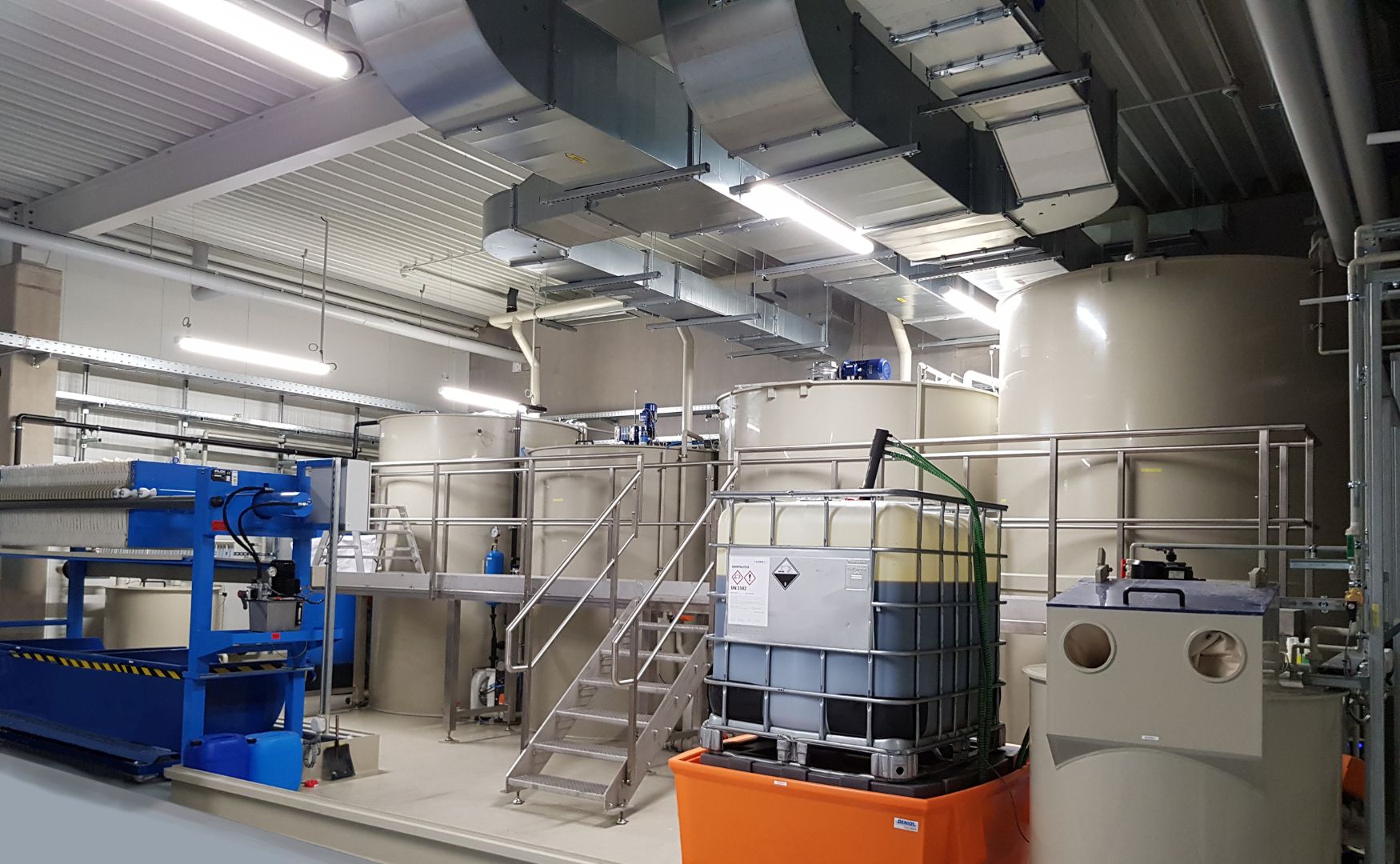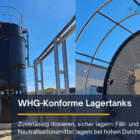A pickling plant is an industrial plant or part of a plant in which oxide layers, impurities or scale are removed from metallic materials using chemical processes. This is done using pickling solutions, which typically contain acids or alkalis. Pickling is used to prepare metallic surfaces for subsequent processing, such as coating, electroplating or painting, and ensures that the surfaces are metallically bright and free of residues.
In industrial water and wastewater treatment, the treatment of wastewater from pickling plants is of crucial importance, as this wastewater often contains heavy metals, acid residues and other pollutants that must be treated before being discharged into the environment.
Table of contents
Technical background of the pickling process
Pickling removes unwanted surface impurities from metals through contact with a chemical pickling solution. This process is mainly used in metal processing and surface technology to prepare metal surfaces for further processing steps or to increase corrosion resistance.
The chemical reactions in the pickling process vary depending on the material, the acid used and the aim of the pickling process. Frequently used pickling solutions are
- Hydrochloric acid (HCl): Particularly effective for removing scale and corrosion products from iron and steel.
- Sulphuric acid (H₂SO₄): Widely used for pickling steel, especially in steel production. It is often used in high concentrations as it effectively removes scale and oxides.
- Hydrofluoric acid (HF) and nitric acid (HNO₃): These acids are often used in combination, especially for pickling stainless steels and aluminum. They are able to remove particularly resistant oxide layers.
- Phosphoric acid (H₃PO₄): Used to passivate the surface and protect it from corrosion.
In addition to acids, alkalis such as sodium hydroxide (NaOH) can also be used for alkali pickling, especially for aluminum or zinc. In some cases, inhibitors are added to the pickling solutions to slow down the attack of the acid on the base metal and ensure the uniform removal of impurities.
Pickling process and systems
Depending on the application and the material to be treated, pickling processes can be carried out using different methods:
Immersion pickling: The workpiece is immersed in a pickling bath in which the chemical reaction takes place. This process is widely used in mass production, e.g. in the steel and aluminum industry. Complete immersion ensures that even complex geometries are fully treated.
Spray pickling: The pickling solution is sprayed onto the metal surface. This process is often used for large-area or continuously produced materials, such as sheet metal coils or pipes, in order to efficiently control contact with the pickling solution.
Electrochemical pickling: In this process, an electric current is used to accelerate the chemical reaction. It is mainly used for stainless steels as it ensures a uniform surface treatment.
Waste water from pickling plants and its treatment
The wastewater produced in pickling plants usually contains high concentrations of acids, heavy metals (such as iron, nickel, zinc, chromium), organic residues and dissolved oxides. The treatment of this wastewater is of crucial importance, as untreated wastewater must not be released into the environment.
Various physico-chemical processes are used to treat wastewater from pickling plants:
1. neutralization:
Waste pickling water often contains excess acids that need to be neutralized. This is done by adding alkalis such as sodium hydroxide or milk of lime (Ca(OH)₂) to bring the pH value to a neutral range. Precise pH control is crucial to ensure optimum conditions for the subsequent treatment stages.
2. precipitation and flocculation:
Precipitants such as iron(III) chloride or calcium-based precipitants are used to remove heavy metals and dissolved solids from the pickling wastewater. These cause the formation of insoluble compounds, which are then aggregated into larger flocs by flocculants such as polymers and subsequently separated by sedimentation or filtration.

Photo: CP system ALMA CHEM MCW for the removal of heavy metals, AOX and hydrocarbons
3. ion exchange:
In special cases, particularly in the treatment ofwastewater containing heavy metals, ion exchange can be used to selectively remove dissolved metal ions. This process is often used for low concentrations of heavy metals or for polishing treatment.

Photo: ALMA ION ion exchanger system in GRP tanks
4. membrane process
Ultrafiltration (UF) and reverse osmosis (RO) can be operated after treatment in CP plants to remove fine particles and dissolved salts from wastewater. These technologies are increasingly being used in the recovery and reuse of process water in pickling plants in particular.

Photo: ALMA BHU BiosS-Treat reverse osmosis system for recovering process water from wastewater
Environmental and safety aspects
The wastewater from pickling plants is harmful to the environment due to its composition and therefore requires strict monitoring and treatment before it can be discharged into the environment. The main objectives of wastewater treatment in pickling plants are:
- Reduction of the acid concentration through neutralization.
- Removal of heavy metals and dissolved solids by precipitation, flocculation and filtration.
- Avoidance of environmental pollution through the recovery and reuse of chemicals, especially acids.
In addition, strict safety precautions must be taken in pickling plants, as the acids used are highly corrosive and dangerous. The use of personal protective equipment (PPE) and well-ventilated facilities is essential to minimize the risk to employees.
Conclusion
Pickling is an indispensable process in metalworking that is used to clean metallic surfaces and prepare them for subsequent processing steps. The chemical processes involved in pickling require careful handling and the correct selection of pickling solutions, depending on the type of metal to be treated. At the same time, the resulting wastewater poses a major challenge and requires comprehensive treatment by CP systems such as the ALMA CHEM MCW to neutralize and remove acids, heavy metals and other pollutants.








